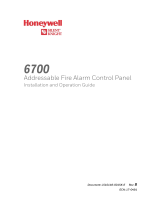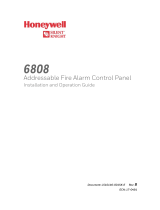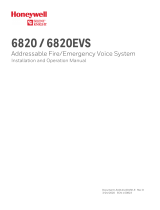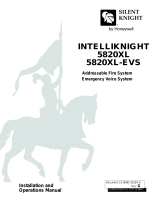Page is loading ...

1 I56-6648-001
6/6/2019
GENERAL DESCRIPTION
The L-Series low frequency series of notification appliances offers a range
of low frequency sounder and low frequency sounder/strobe products for
wall and ceiling applications. Studies have shown that low frequency audible
devices that operate around 520Hz are more effective in waking individuals
in sleeping areas. These products are electrically backward compatible with
the previous generation of SpectrAlert Advance notification appliances. The
2-wire products fit systems where a single NAC controls both sounder and
strobe. The System Sensor MDL3 module may be used to provide synchro-
nization.
Sounder-only models are approved for wall and ceiling installations.
FIRE ALARM SYSTEM CONSIDERATIONS
The National Fire Alarm Code, NFPA 72, requires that all sounders, used for
building evacuation produce temporal coded signals. Signals other than those
used for evacuation purposes do not have to produce the temporal coded sig-
nal. The National Fire Alarm Code, NFPA 72, requires that audible appliances
installed in sleeping areas produce a low frequency alarm signal that shall
be a square wave or provide equivalent awakening ability (effective Jan. 1,
2014). System Sensor recommends spacing notification appliances in compli-
ance with NFPA 72.
LOOP DESIGN AND WIRING
The system designer must make sure that the total current drawn by the de-
vices on the loop does not exceed the current capability of the panel supply,
and that the last device on the circuit is operated within its rated voltage. The
current draw information for making these calculations can be found in the
tables within this manual. For convenience and accuracy, use the voltage drop
calculator on the Tools menu of the System Sensor website.
When calculating the voltage available to the last device, it is necessary to
consider the voltage drop due to the resistance of the wire. The thicker the
wire, the smaller the voltage drop. Wire resistance tables can be obtained
from electrical handbooks. Note that if Class A wiring is installed, the wire
length may be up to twice as long as it would be for circuits that are not fault
tolerant.
NOTE: The total number of strobes on a single NAC must not exceed 69 for
24 volt applications. Loop resistance on a single NAC should not exceed 120
ohms for 24 volt.
NOTE: A shorting spring is provided between terminals 2 and 3 of the mount-
ing plate to enable wiring checks after the system has been wired, but prior
to installation of the final product. This spring will automatically disengage
when the product is installed, to enable supervision of the final system.
Removal of a notification device will result in an open circuit indication on
the NAC.
INSTALLATION AND MAINTENANCE INSTRUCTIONS
L-Series
Low Frequency Sounder/Strobes
For use with the following models: P2RL-LF, P2WL-LF, HRL-LF, HWL-LF, HGRL-LF, HGWL-LF, HCRL-LF, HCWL-LF
PRODUCT SPECIFICATIONS
Operating Temperature: 32°F to 120°F (0°C to 49°C)
Humidity Range: 10 to 93% Non-condensing
Strobe Flash Rate: 1 flash per second
Nominal Voltage (Low Frequency Sounder): Regulated 24VDC/FWR
Nominal Voltage (Low Frequency Sounder/Strobe): Regulated 24VDC/FWR
Operating Voltage Range (includes fire alarm panels with built in sync): 16 to 33V (24V nominal)
Operating Voltage with MDL3 Sync Module: 16.5 to 33V (24V nominal)
Input terminal wire gauge: 12 to 18 AWG
DIMENSIONS FOR PRODUCTS AND ACCESSORIES
WALL PRODUCTS Length Width Depth
Standard Sounder
5.6" (143mm) 4.7" (119mm) 1.5" (38 mm)
Sounder Strobe
5.6” (143mm) 4.7” (119mm) 1.93" (49mm)
Compact Sounder
5.26" (133 mm) 3.46" (88 mm) 1.5" (38 mm)
Standard device with SBBRL/WL Surface Mount Back Box 5.7" (145 mm) 4.8"(120mm) 3.3" (84mm)
C
ompact device with
SBBGRL/WL Surface Mount Back Box
5.4" (137 mm) 3.6"(91mm) 3" (76mm)
NOTE: SBBRL/WL Surface Mount Back Box intended only for standard sounder and sounder strobe. SBBGRL/WL Sur-
face Mount Back Box intended for compact sounder.
CEILING PRODUCTS Diameter Depth
Sounder
6.83" (173.5mm) 1.4" (36mm)
Sounder with SBBCRL/WL Surface Mount Back Box 6.92" (175.8mm) 3.9" (99mm)
JUNCTION BOX OPTIONS
Standard Indoor Products: 4" x 4" x 1½", Single Gang, Double Gang, 4" Octagon, SBBRL/WL (wall), SBBCRL/WL (ceiling)
Compact Indoor Products: Single Gang, SBBGRL/WL (wall)
NOTICE: This manual shall be left with the owner/user of this equipment.
3825 Ohio Avenue, St. Charles, Illinois 60174
800/736-7672, FAX: 630/377-6495
www.systemsensor.com
I56-6648-001

2 I56-6648-001
6/6/2019
FIGURE 3. WALL MOUNT LOW-FREQUENCY SOUNDER WITH JUNCTION
BOX
A0580-00
FIGURE 4. WALL MOUNT LOW-FREQUENCY SOUNDER WITH SURFACE-
MOUNT BACK BOX
A0579-00
FIGURE 5. CEILING MOUNT LOW-FREQUENCY SOUNDER WITH
JUNCTION BOX
A0578-00
FIGURE 6. CEILING MOUNT LOW-FREQUENCY SOUNDER WITH
SURFACE-MOUNT BACK BOX
A0577-00
FIGURE 7. WALL MOUNT LOW-FREQUENCY SOUNDER STROBE WITH
JUNCTION BOX
A0583-00
MOUNTING AND REMOVING APPLIANCE
1. Attach mounting plate to junction box. (See Figures 3, 5, 7, and 9.)
2. Connect field wiring to terminals. (See Figures 1 and 2.)
3. If the product is not to be installed at this point, use the paint cover to
prevent contamination of the mounting plate.
4. To attach product to mounting plate:
a. Remove the protective dust cover.
b. Hook the tabs on the top of the product housing into the grooves on
mounting plate.
c. Pivot the product into position to engage the terminals on the mount-
ing plate. Make sure that the tabs on the back of the product housing
fully engage with the mounting plate.
d. Hold product in place with one hand, and secure product by tighten-
ing the single mounting screw in the front of the product housing.
5. To remove products from the mounting plate, press the locking button
after loosening the captivate mounting screw. (Ceiling models only)
INSTALLING A SURFACE MOUNT BACK BOX
1. The surface mount back box may be secured directly to the wall or ceil-
ing. Use of grounding bracket with ground screw is optional. (See Figures
4, 6, 8, and 10.)
2. The wall mount box must be mounted with the up arrow pointing up.
(See Figure 12.)
3. Threaded knockout holes are provided for the sides of the box for ¾ inch
and ½ inch conduit adapter. Knockout plugs in the back of the box can
be used for ¾ inch and ½ inch rear entry.
4. To remove the ½ inch or ¾ inch knockout, place the blade of a flat-head
screwdriver along the outer edge and work your way around the knock-
out as you strike the screwdriver. (See Figure 13.)
NOTE: Use caution not to strike the knockout near the top edge of the
surface mount back box.
5. V500 and V700 wiremold raceways are also provided. Use V500 for low
profile applications and V700 for high profile applications.
6. To remove the knockout, turn pliers up. (See Figure 13.)
7. Attach the mounting plate to the surface mount back box using the four
unpainted screws. (See Figures 4, 6, 8, and 10.)
8. To wire and attach the product, follow steps 4 and 5 of “Mounting and
Removing Appliance” (above).
FIGURE 1. WIRING DIAGRAM
+
–
+
–
INPUT
FROM
FA
CP
OR
PRIOR
DEVICE
OUTPUT
TO
NEXT
DEVICE
OR EOL
A0367-02
FIGURE 2. WIRING TERMINALS, SHORTING SPRING, AND STRIP GUIDE
Shorting Spring
Strip Guide
WIRING TERMINALS
1. Negative (-). Line in and out
2. Positive (+). Line in and out
3. Positive (+). Line in and out
A0475-01

3 I56-6648-001
6/6/2019
FIGURE 8. WALL MOUNT LOW-FREQUENCY SOUNDER STROBE WITH
SURFACE-MOUNT BACK BOX
A0584-00
FIGURE 9. COMPACT WALL MOUNT LOW-FREQUENCY SOUNDER WITH
JUNCTION BOX
A0581-00
FIGURE 10. COMPACT WALL MOUNT LOW-FREQUENCY SOUNDER
WITH SURFACE-MOUNT BACK BOX
A0582-00
CAUTION
Factory finish should not be altered: Do not paint!
CAUTION
Do not over tighten mounting plate screws; this may cause mounting plate
to flex.
TONE AND CANDELA SELECTION
Tables 1 and 2 list current draw and sound output for available settings. Fig-
ures 14 – 16 list the minimum light output requirements per UL1971.
Sounder tone and volume: Turn the rotary switch on the back of the product.
Candela: Adjust the slide switch on the rear of the product to the desired can-
dela setting. Candela setting will display in the small window on the front of
the unit. All products meet the light output profiles specified in the appropri-
ate UL Standards.
TABLE 2. LOW FREQUENCY WALL AND CEILING SOUNDER ONLY
CURRENT DRAW (mA)
Pos
Sound
Patterns
Volume
Setting
Current Draw (mA)
Sound Output (dBA)
Reverberant
16–33 Volts
16-33 V
DC FWR DC FWR
1 Temp 3
High
108 150
80 80
2 Temp 3
Low
78 76
76 76
3 Temp 4
High
111 151
80 80
4 Temp 4
Low
80 76
76 76
5 Continuous
High
111 151
80 80
6 Continuous
Low
80 76
76 76
7* Coded
High
111 151
80 80
8* Coded
Low
80 76
76 76
*NOTE: For coded tones, temporal coding must be provided by the NAC. If the
NAC voltage is held constant, the sounder output will remain constantly on.
Coded ratings provided are for continuous voltage.
TAMPER SCREW
For tamper resistance, the standard captive screw may be replaced with a Torx
screw, ordered separately.
To remove the captive screw, back out the screw and apply pressure to the
back of the screw until it disengages from the housing. Replace with Torx
screw. (See Figure 11.)
FIGURE 11. TAMPER SCREW
T15 Torx
#6-32, 5/8"
SCREW-TMPR-50
A0478-00
FIGURE 12. SURFACE MOUNT BACK BOX UP ARROW
A0481-00
FIGURE 13. KNOCKOUT AND V500/V700 REMOVAL FOR SURFACE
MOUNT BACK BOX
½ inch
or ¾ inch
Wire Mold Removal
A0465-01
A0466-01
TABLE 1. WALL SOUNDER STROBE CURRENT DRAW (mA) AND SOUND OUTPUT (dBA)
Current draw (mA)
Sound Output
(dBA)
Pos Tone
Volume
Setting
16-33 VDC 16-33 FWR
16-33 V
15cd 30cd 75cd 95cd 110cd 135cd 185cd 15cd 30cd 75cd 95cd 110cd 135cd 185cd
DC FWR
1 Temp 3 High 98 115 158 173 182 212 266 136 153 188 206 228 258 304 80 80
2 Temp 3 Low 98 102 141 162 173 202 255 150 150 176 194 216 242 280 76 76
3 Temp 4 High 98 108 137 151 178 202 252 200 198 169 188 212 242 290 80 80
4 Temp 4 Low 102 104 122 136 163 187 237 176 174 154 173 197 227 275 76 76
5 Continuous High 141 158 198 216 234 264 305 190 207 249 268 289 321 368 80 80
6 Continuous Low 120 128 179 196 215 244 285 165 182 226 244 266 297 342 76 76

4 I56-6648-001
©2019 System Sensor. 6/6/2019
System Sensor
®
is a registered trademark of Honeywell International, Inc.
The sounder and/or strobe will not work without power. The sounder/strobe gets its
power from the fire/security panel monitoring the alarm system. If power is cut off for
any reason, the sounder/strobe will not provide the desired audio or visual warning.
The sounder may not be heard. The loudness of the sounder meets (or exceeds) cur-
rent Underwriters Laboratories’ standards. Studies have shown that the low frequency
sounder (520Hz) is more effective at waking individuals in sleeping spaces, especially
individuals that may have recently used drugs or drinking alcoholic beverages. The
sounder may not be heard if it is placed on a different floor from the person in hazard or
if placed too far away to be heard over the ambient noise such as traffic, air conditioners,
machinery or music appliances that may prevent alert persons from hearing the alarm.
The low frequency sounder may not be heard by persons who are hearing impaired.
NOTE: Strobes must be powered continuously for sounder operation.
The signal strobe may not be seen. The electronic visual warning signal uses an extremely
reliable xenon flash tube. It flashes at least once every second. The strobe must not be
installed in direct sunlight or areas of high light intensity (over 60 foot candles) where the
visual flash might be disregarded or not seen. The strobe may not be seen by the visually
impaired.
The signal strobe may cause seizures. Individuals who have positive photoic response to
visual stimuli with seizures, such as persons with epilepsy, should avoid prolonged exposure
to environments in which strobe signals, including this strobe, are activated.
The signal strobe cannot operate from coded power supplies. Coded power supplies
produce interrupted power. The strobe must have an uninterrupted source of power in
order to operate correctly. System Sensor recommends that the sounder and signal strobe
always be used in combination so that the risks from any of the above limitations are
minimized.
WARNING
THE LIMITATIONS OF LOW FREQUENCY HORN/STROBES
FCC STATEMENT
System Sensor Strobes and Horn/Strobes have been tested and found to comply with the
limits for a Class B digital device, pursuant to part 15 of the FCC Rules. These limits are
designed to provide reasonable protection against harmful interference when the equip-
ment is operated in a commercial environment. This equipment generates, uses, and
can radiate radio frequency energy and, if not installed and used in accordance with the
instruction manual, may cause harmful interference to radio communications. Operation
of this equipment in a residential area is likely to cause harmful interference in which
case the user will be required to correct the interference at his own expense.
For the latest Warranty information, please go to:
http://www.systemsensor.com/en-us/Documents/E56-4000.pdf
For Limitations of Fire Alarm Systems, please go to:
http://www.systemsensor.com/en-us/Documents/I56-1558.pdf
Speakers only: For the latest Important Assembly Information, please go to:
http://www.systemsensor.com/en-us/Documents/I56-6556.pdf
Warranty
Limitations of
Fire Alarm Systems
Speakers Only:
Assembly Information
SUPPLEMENTAL INFORMATION
FIGURE 15. VERTICAL
DISPERSION, WALL TO FLOOR
Degrees* Percent of Rating
0 100
5-30 90
35 65
40 46
45 34
50 27
55 22
60 18
65 16
70 15
75 13
80 12
85 12
90 12
Thisisgenerated textforfigtxt.
A0469-00
*Tolerance of ±1 degree is permitted.
FIGURE 14. LIGHT OUTPUT –
HORIZONTAL DISPERSION
Degrees* Percent of Rating
0 100
5-25 90
30-45 75
50 55
55 45
60 40
65 35
70 35
75 30
80 30
85 25
90 25
Compound 45
to the left
24
Compound 45
to the right
24
A0467-00
DEVICE AND SYSTEM SECURITY
Before installing this product ensure that the tamper seal on the packaging is present and unbroken and the product has not been tampered with since leaving the factory. Do not
install this product if there are any indications of tampering. If there are any signs of tampering the product should be returned to the point of purchase.
It is the responsibility of the system owner to ensure that all system components, i.e. devices, panels, wiring etc., are adequately protected to avoid tampering of the system that could
result in information disclosure, spoofing, and integrity violation.
/





